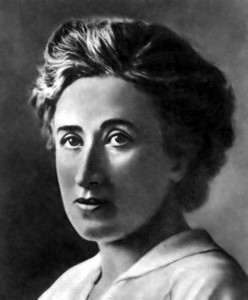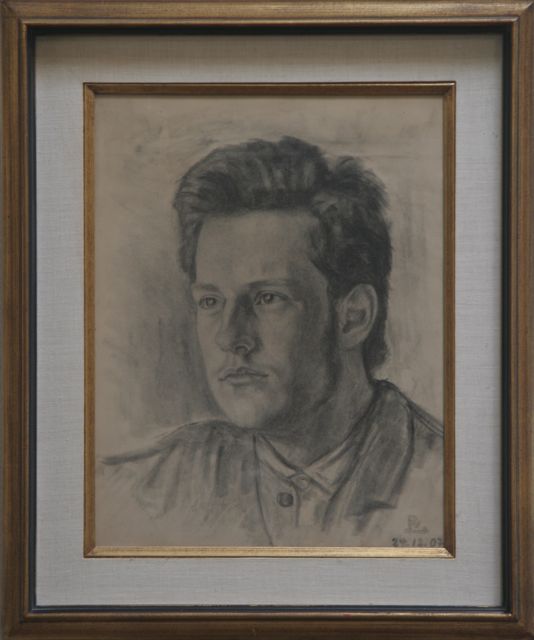Rosa Luxemburg
Portrait of Karl Kautsky by Rosa Luxemburg, 1907 – NOT FOR SALE
 Rosa Luxemburg spent most of the last three years of her life in prison in Berlin. But only one year of this time was legally justified by an actual conviction. Her “big crime” was the publication of the revolutionary magazine called the “Spartakus Connection” for which she wrote all her articles under the pseudonym “Junius.” These three years in prison provided Rosa the only ”free” time in her life during which she was able to write, but also to dedicate herself to another great passion- her talent for expressing her sense of beauty. She was a born artist who preferred sketching and drawing to painting. As far as anyone knew, she had no special training in art. She just had a great need to paint or sketch every tree or flower that she admired, as well as many pets of her friends. According to her school records of the Women’s Gymnasium in Warsaw from which she graduated in 1887, she received the highest marks and accolades for her exquisite artwork. There may still be some other paintings by Rosa somewhere in Europe, which have not been attributed to her so far. But we do know of one- the wonderful portrait Rosa drew of the young son Karl Jr. of her closest friends Karl and Louise Kautsky, when he was just sixteen years old. The likeness Rosa achieved is incredible! The painting has always remained in their family and serves as the living proof of Rosa’s exceptional talent.
Rosa Luxemburg spent most of the last three years of her life in prison in Berlin. But only one year of this time was legally justified by an actual conviction. Her “big crime” was the publication of the revolutionary magazine called the “Spartakus Connection” for which she wrote all her articles under the pseudonym “Junius.” These three years in prison provided Rosa the only ”free” time in her life during which she was able to write, but also to dedicate herself to another great passion- her talent for expressing her sense of beauty. She was a born artist who preferred sketching and drawing to painting. As far as anyone knew, she had no special training in art. She just had a great need to paint or sketch every tree or flower that she admired, as well as many pets of her friends. According to her school records of the Women’s Gymnasium in Warsaw from which she graduated in 1887, she received the highest marks and accolades for her exquisite artwork. There may still be some other paintings by Rosa somewhere in Europe, which have not been attributed to her so far. But we do know of one- the wonderful portrait Rosa drew of the young son Karl Jr. of her closest friends Karl and Louise Kautsky, when he was just sixteen years old. The likeness Rosa achieved is incredible! The painting has always remained in their family and serves as the living proof of Rosa’s exceptional talent.
The hundreds of amazing letters that Rosa wrote to her many beloved friends, have been carefully preserved by them and eventually were published in a rare collection. They provide a wealth of information about her activities, particularly during her prison years, when she had time to write. She describes her intense work schedule, the many hours of everyday she spent at her desk writing, sometimes lifting her eyes to glance through the window above the desk to observe the view of the prison courtyard where a lilac bush was growing that she had planted there herself. She enjoyed many privileges in the prison due to her astonishing ability to form deep friendships with the working class people (in this case- the prison guards). She actually made the most of her time there by reading an incredible selection of varied literature, political as well as classical, polemics as well as poetry.
We get a sense of her physical suffering from various ailments, and her mood swings. We also find many expressions of her profound knowledge of plants and the animal kingdom. She was particularly fond of birds, which she loved to watch from her prison window. She was even able to care for a few wounded ones in her little cell. The guards would provide her with birdseed and other things she needed for them.
One great truth emerges again and again from the letters- the deepest roots of Rosa’s revolutionary activities come from her all-encompassing love for all living creatures.
The “other” Rosa Luxemburg, not the fiery political leader, only her closest friends ever really had the chance to know intimately. The letters she had written to them are all we have to give us a clear picture of her inner self. More than anything else, she wanted to be good- to help all those in need- that was the longing in her soul in all the days and nights she spent in loneliness in prison.
Rosa bore this suffering with the dame courage and strength that had accompanied this small and insignificant looking woman throughout her whole life. Her empathy with all the oppressed of the world touches us deeply, as she describes some small acts of mercy she carried out to help the disadvantaged, be they humans or animals.
Rosa said, “This is most important: to be simply and unaffectedly good; that alone can solve everything and bind us all together more effectively than mere cleverness!”



 And many more
And many more